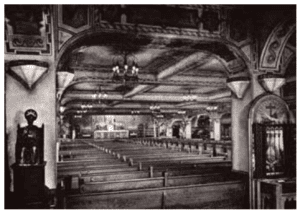The vacancy created by the death of Father Anselm Kennedy on June 12, 1929 was soon filled by the appointment of Father Mathias Faust, who was the Guardian of the Franciscan community at 31st Street since 1925. In 1931 he would be elected to serve as Minister Provincial for a third term, but during his two short years as Pastor he managed to plan and complete the lower church known as the National Shrine of Saint Anthony of Padua.
 When the construction of the lower church was first conceived by Father Mathias, there immediately arose among the artists the idea of bringing to American soil something of the style of the medieval Franciscan sanctuaries. The execution of this idea in the crypt of St. Francis of Assisi was proclaimed as a work of art unequaled in its beauty.
When the construction of the lower church was first conceived by Father Mathias, there immediately arose among the artists the idea of bringing to American soil something of the style of the medieval Franciscan sanctuaries. The execution of this idea in the crypt of St. Francis of Assisi was proclaimed as a work of art unequaled in its beauty.
Shortly after the lower church was dedicated on November 1, 1931, a perpetual Christmas Crib was installed. The glass-encased shrine reproduces three distinct scenes in the life of the infant Jesus: the Nativity, the Flight into Egypt, and the Hidden Life of the Holy Family in Nazareth. In a vault of blue sky over the crib are hundreds of twinkling stars. The alcove is which the crib is set is separated by a large glass panel with a kneeling bench placed before it. Within the crib is a relic taken from the grotto of the Nativity in Bethlehem. The statues of the crib were made by the Liturgical Art Company of Munich, Germany. While it is common for all Catholic churches to have a Nativity scene during the Christmas season, many of the Franciscan churches in Europe have a year-round crib as a permanent reminder of St. Francis’ devotion to the Christ Child and the first Christmas Crib he built at Greccio in 1223. The Incarnation remains central to Franciscan spirituality and devotion, and this is symbolized by the presence of the perpetual crib in the lower church.

This series of articles on the history of our parish is adapted from the writings of Fr. Flavian Walsh, O.F.M., Pastor from 1985-87.

